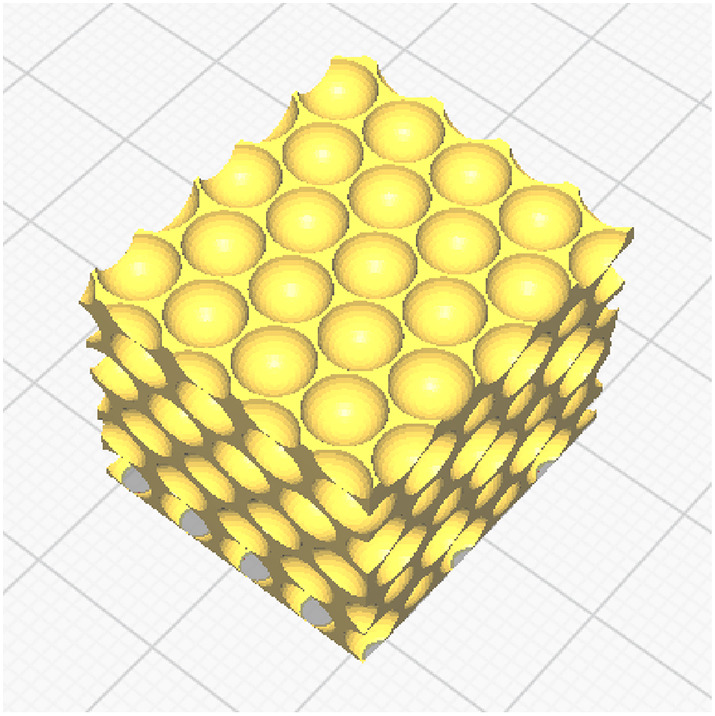In the paper “3D printed cork / polyurethane composite foams,” authors N. Gama, A. Ferreira, and A. Barros-Timmons delve further into the world of enhanced materials for better performance in thermal applications. Here, they explore the use of cork in creating a 3D printing composite for PU foams—often used in insulation, including the ‘sprayed in place’ foam, popular due to:
- Low conductivity
- High mechanical stability
- Good chemical stability
Because of the low thermal conductivity, the authors state that PU foams are more likely to offer strength in required applications and can be controlled for specific functionality by adjusting how pores are filled via reactants—making such products useful in the aerospace and automotive industries for both sound and impact absorption.
Materials like cork can also be used to further reduce thermal conductivity and act as a damping agent, and have been found effective in previous studies in liquified form too. With the advent of 3D printing and additive manufacturing, a variety of new geometries can be produced, and in many new materials—including a wide range of composites today. TPU (Pearlthane 11H94) was used in this study, with cork powder residue. The composite material was mixed to create a filament then used to fabricate the PU forms with an Anycubic Chiron 3D printer.
The researchers found the cork to have a ‘pronounced effect’ on the filament; however, while increasing the amount of cork residue, they noticed it caused the filament to become ‘rougher,’ suggesting ‘insufficient impregnation’ of the cork.
“Nonetheless, voids were not observed, which are known to be starting points of material failure under stress, indicating good wettability of the cork by the TPU,” stated the researchers.
The cork also decreases the strength of tensile properties in the 3D printed foam samples, with the authors reporting a reduction of up to 15 percent. While they point out that this does ‘suggest lower bond performance,’ interlayer bonding may not be compromised as the foams are more vulnerable to compression stress. Because of that, the team does not expect maximum tension and elongation at break to cause any defect in the performance of the 3D printed foam samples.
“From the results obtained, it was observed that the presence of cork affects the morphology of the ensuing foams, leading to rougher skeletons as well as to the presence of voids in the struts of the resulting PU foams. Due to the presence of cork as well as to the presence of voids, the resulting foams presented lower density, lower thermal conductivity and proved to be more flexible. Moreover, the addition of cork did not affect the thermal stability of the composites and despite of affecting the layer-to-layer bonding performance may not compromise its application,” concluded the researchers.
“Besides their thermal insulation properties, their elastomeric behavior suggests that the 3D printed foams produced may be used as thermal insulation, sound absorption or as damping materials. Moreover, progresses in the 3D printing technology, may increase the added value of the 3D printed foams for example in medical applications such as wound care or surgical aids. Yet, thorough compatibility tests would be required.”
You might be surprised to find out how often foam is the center of 3D printing research and innovation, from ink to aerospace applications for NASA, and even syntactic filaments designed to create foam for marine use. Find out more about composites in foam fabrication here. Discuss this article and other 3D printing topics at 3DPrintBoard.com.
[Source / Images: 3D printed cork / polyurethane composite foams]Subscribe to Our Email Newsletter
Stay up-to-date on all the latest news from the 3D printing industry and receive information and offers from third party vendors.
Print Services
Upload your 3D Models and get them printed quickly and efficiently.
You May Also Like
Heating Up: 3D Systems’ Scott Green Discusses 3D Printing’s Potential in the Data Center Industry
The relentless rise of NVIDIA, the steadily increasing pledges of major private and public investments in national infrastructure projects around the world, and the general cultural obsession with AI have...
Formlabs Teams Up with DMG MORI in Japan
In late June, Nick Graham, Chief Revenue Officer at Formlabs, announced on LinkedIn that the company had partnered with DMG MORI, one of the world’s leading machine tool companies, to...
EOS in India: AM’s Rising Star
EOS is doubling down on India. With a growing base of aerospace startups, new government policies, and a massive engineering workforce, India is quickly becoming one of the most important...
3D Printing News Briefs, June 25, 2025: R&D Materials, 3D Printed Veneers, & More
In today’s 3D Printing News Briefs, 3DXTECH has launched a program that gives customers early access to experimental materials, and the first Lithoz CeraFab Multi 2M30 in the Czech Republic...








































